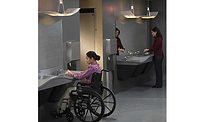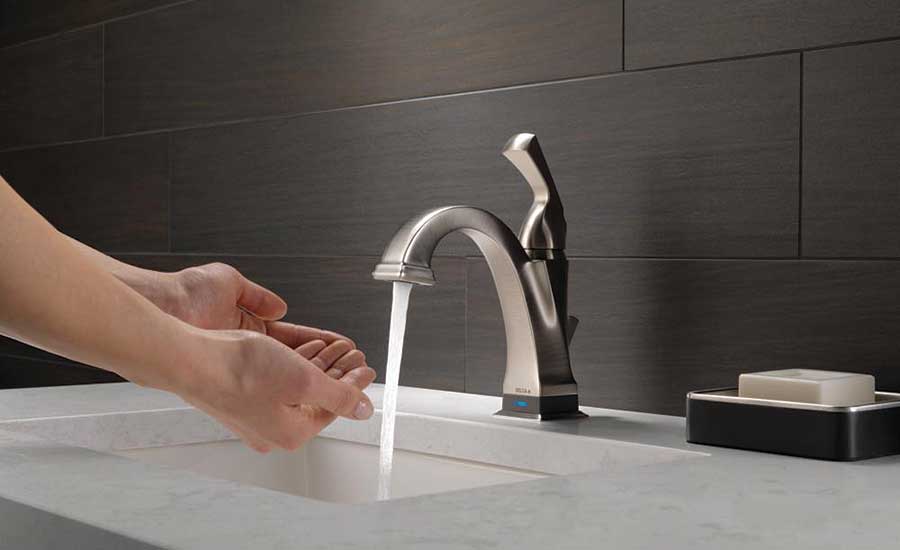Touchless technology improves faucet usability

The Delta Dryden Single Handle Vessel Lavatory Faucet with Touch2O.xt Technology features a 4-inch sensing field around the entire faucet. Once the handle is moved to an on position, the faucet automatically responds when a user approaches the sensing field. Photo credit: Delta

Controlled by smart technology, KWC’s ONO Touch Light Pro allows users to control water temperature and volume with just a finger tap — or from across the room, with wireless controllers. Photo Courtesy: KWC


From faucets that work with the wave of a hand to fixtures you can control with your voice, the residential touchless faucet market has grown in the past few years.
Some need to have the handle in the on position first; others are completely hands-free and may not even have a handle. Cinaton released a completely touch-free five-sensor faucet for the bathroom and kitchen that allows users to turn water flow on/off as well as adjust water temperature and flow without touching any part of faucet. Three user-defined water flow and temperature settings provide a convenient water experience and save users from manually adjusting favorable water condition.
“Completely touch-free faucets will be the trend for the next five to 10 years due to convenience and personal hygiene,” says Chung-Chia Chen, inventor and founder of Cinaton. “Especially during flu season, the completely touch-free faucet can protect family members from cross contamination. We are also further developing voice control on this completely touch-free faucet to connect to the smart-home system for more convenience.”
Some manufactures have kept the faucet handle in their designs for those homeowners who would prefer to have both options available to them. Delta’s faucets with Touch2O.xt Technology feature a 4-inch sensing field, which only responds once the handle is moved to an on position. From there, the faucet automatically responds when a user approaches the sensing field — no infrared sensor is used. Moving hands out of range intuitively shuts off the water flow within seconds when not needed.
“The Lahara and Addison single-handle bathroom faucets were first to offer Touch2O.xt and launched in 2011,” says Peggy Gallagher, product manager at Delta Faucet Co. “Over the years, we have made improvements to the technology platform to improve reliability and installation. We have also added new features, such as TempSense, which is an integrated LED light that shows water temperature changing from blue to magenta to red as temperature increases.”
The kitchen is the workhorse of the home, and consumers are continuing to look for ways to incorporate tech to enhance and simplify their experience in this space, notes Scott Jackson, senior manager in kitchen at Moen Wholesale.
“Electronic touchless and touch on/off kitchen faucets have rapidly gained in popularity because of their convenient operation and because this technology can help reduce the risk of cross-contamination in food preparation, and we believe this trend will continue in the future,” says Noelle Giblin, senior director of faucets at LIXIL Americas. “Electronic faucets are also very convenient in situations where the user’s hands are full or dirty, so it’s no surprise that this technology is taking off.”
Gallagher notes the use of these products has gained momentum over the years — especially with multi-generational homes.
“We continue to see some of the trends from our commercial products migrate into residential, so we expect to see technologies boasting eco benefits in the future,” she says. “Whether it’s harnessing energy or water efficiency, these technologies could easily transfer to residential applications.”
What’s next for touchless tech
The newest touchless faucet trends place an emphasis on improved technology that simplifies the user experience in comparison to the earliest residential models. Sensor technology and placement has improved to avoid accidental triggering of the faucet. In the case of GROHE Foot Control, which can operate the faucet with a tap of the foot on an activation plate installed in the base of the kitchen cabinet, the sensors have been removed from the work area of the sink altogether.
“Many of the newest hands-free faucets on the market today offer specialized features that make them even more convenient to use,” Giblin says. “We’ve also been able to integrate this hands-free technology with high-efficiency operation, creating faucet styles that showcase water-conserving 1.5 gpm flow rate versus the 2.2 gpm of other standard models.”
“As personalization becomes stronger in our culture and mindset, we will see this [trend’s] demand grow even more in the plumbing industry,” says Erin Geiger, Kohler product manager for kitchen faucets. “We see integrated technology becoming a more widely-accepted progression for our categories and are excited [for] our new smart plumbing lines. The launch of Kohler Konnect and the upcoming launches of Sensate and Beckon faucets with Konnect mark the next generation of faucet technology — voice control capabilities.”
Since its initial launch, Pfister’s product team has been consistently evolving its touchless products with the goals of scalability, reducing component sizes and optimizing power consumption.
“Updates to the valve configuration have enabled us to fit the technology into a smaller envelope, simplify the installation process, and offer a price that is competitive with non-electronic faucets,” says Melissa Zellner, product marketing manager at Pfister. “Stellen with React meets both U.S. Department of Energy Efficiency VI Standards and IEC Protection Class 2 and is also UL-compliant. As a result, Pfister can offer low-energy-consumption, environmentally conscious products that are more accessible to the everyday consumer.”
Many of the sensor faucets are also water-use conscious and have a timed automatic shutoff when not in use.
“Homes will be more connected as technology advances and integrating technology into homes will become the standard for new construction,” Zellner says. “The technology will become more accessible, affordable, and inter-connected with voice activation. Ultimately, there will be seamless integration that enables programmable settings, haptic feedback, and consumption monitoring.
“It is exciting to integrate this technology into everyday life. Ultimately, people are investing more and spending more time with their families in the kitchen. Faucets are becoming a statement piece for the home while everyday technologies improve their quality of life and experience as automation increases convenience.”
Installation
Installation of electronic faucets is more involved than standard faucets. To help save time, contractors can consider models that offer improved installation options.
For example, the American Standard Avery Selectronic hands-free faucet arrives fully assembled from the factory, with stainless steel supply hoses that are pre-installed and fully integrated with the faucet. The faucet was designed with intuitive, clearly labeled connections for electronics and waterways to help take the guesswork out of installation. Improvements like this make an electronic faucet quicker and easier to install, encouraging contractors to recommend these technologically advanced models to their clients.
Based on trade feedback, Moen’s MotionSense faucet installations have been made even easier with streamlined steps and a reduction in the overall time to complete the install. Moen streamlined the installation process to be similar to that of a standard faucet install, with pre-assembled components and simple push-fit connections. The faucet’s technologies are powered by a battery pack, but also offer the option of an AC adapter. Contractors will need to mount the control box and battery pack under the sink, but only using the tools required for a standard faucet installation. If service is ever required, a diagnostic light will flash in different sequences to pinpoint the problem.
Pfister’s faucets feature hoses with PfastConnect, a tool-free hose connection system that clicks together. The serviceable aerator comes with a complimentary tool for easy accessibility. The included deck plate allows installation in one and three-hole sink configurations. The deep shank accommodates a wide array of countertop depths, and the copper supply lines offer increased strength and durability where the water lines connect to the faucet.
Looking for a reprint of this article?
From high-res PDFs to custom plaques, order your copy today!










